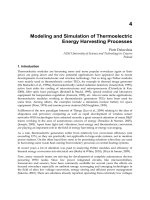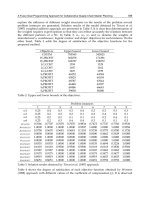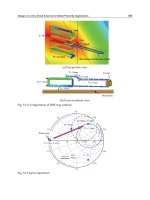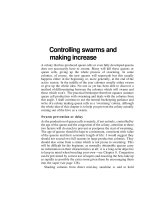Chapter 121. Intraabdominal Infections and Abscesses (Part 7) pdf
Bạn đang xem bản rút gọn của tài liệu. Xem và tải ngay bản đầy đủ của tài liệu tại đây (35.87 KB, 5 trang )
Chapter 121. Intraabdominal
Infections and Abscesses
(Part 7)
Fever is the most common presenting sign of liver abscess. Some patients,
particularly those with associated disease of the biliary tract, have symptoms and
signs localized to the right upper quadrant, including pain, guarding, punch
tenderness, and even rebound tenderness. Nonspecific symptoms, such as chills,
anorexia, weight loss, nausea, and vomiting, may also develop. Only 50% of
patients with liver abscesses, however, have hepatomegaly, right-upper-quadrant
tenderness, or jaundice; thus, half of patients have no symptoms or signs to direct
attention to the liver. Fever of unknown origin (FUO) may be the only
manifestation of liver abscess, especially in the elderly. Diagnostic studies of the
abdomen, especially the right upper quadrant, should be a part of any FUO
workup. The single most reliable laboratory finding is an elevated serum
concentration of alkaline phosphatase, which is documented in 70% of patients
with liver abscesses. Other tests of liver function may yield normal results, but
50% of patients have elevated serum levels of bilirubin, and 48% have elevated
concentrations of aspartate aminotransferase. Other laboratory findings include
leukocytosis in 77% of patients, anemia (usually normochromic, normocytic) in
50%, and hypoalbuminemia in 33%. Concomitant bacteremia is found in one-third
of patients. A liver abscess is sometimes suggested by chest radiography,
especially if a new elevation of the right hemidiaphragm is seen; other suggestive
findings include a right basilar infiltrate and a right pleural effusion.
Imaging studies are the most reliable methods for diagnosing liver
abscesses. These studies include ultrasonography, CT (Fig. 121-4), indium-labeled
WBC or gallium scan, and MRI. More than one such study may be required.
Organisms recovered from liver abscesses vary with the source. In liver infection
arising from the biliary tree, enteric gram-negative aerobic bacilli and enterococci
are common isolates. Unless previous surgery has been performed, anaerobes are
not generally involved in liver abscesses arising from biliary infections. In
contrast, in liver abscesses arising from pelvic and other intraperitoneal sources, a
mixed flora including both aerobic and anaerobic species is common; B. fragilis is
the species most frequently isolated. With hematogenous spread of infection,
usually only a single organism is encountered; this species may be S. aureus or a
streptococcal species such as S. milleri. Results of cultures obtained from drain
sites are not reliable for defining the etiology of infections. Liver abscesses may
also be caused by Candida spp.; such abscesses usually follow fungemia in
patients receiving chemotherapy for cancer and often present when PMNs return
after a period of neutropenia. Amebic liver abscesses are not an uncommon
problem (Chap. 202). Amebic serologic testing gives positive results in >95% of
cases; thus, a negative result helps to exclude this diagnosis.
Figure 121-4
Multilocular liver abscess on CT scan.
Multiple or multilocular abscesses
are more common than solitary abscesses.
[Reprinted with permission from B
Lorber (ed): Atlas of Infectious Diseases, Vol VII: Intra-
abdominal Infections,
Hepatitis, and Gastroenteritis. Philadelphia, Current Medicine, 1996, Fig. 1.22.]
Liver Abscesses: Treatment
(Fig. 121-3)
While drainage—either percutaneous (with a pigtail catheter kept in place)
or surgical—is the mainstay of therapy for intraabdominal abscesses (including
liver abscesses), there is growing interest in medical management alone for
pyogenic liver abscesses. The drugs used for empirical therapy include the same
ones used in intraabdominal sepsis and secondary bacterial peritonitis. Usually, a
diagnostic aspirate of abscess contents should be obtained before the initiation of
empirical therapy, with antibiotic choices adjusted when the results of Gram's
staining and culture become available. Cases treated without definitive drainage
generally require longer courses of antibiotic therapy. When percutaneous
drainage was compared with open surgical drainage, the average length of hospital
stay for the former was almost twice that for the latter, although both the time
required for fever to resolve and the mortality rate were the same for the two
procedures. Mortality was appreciable despite treatment, averaging 15%. Several
factors predict the failure of percutaneous drainage and therefore may favor
primary surgical intervention. These factors include the presence of multiple,
sizable abscesses; viscous abscess contents that tend to plug the catheter;
associated disease (e.g., disease of the biliary tract) requiring surgery; or the lack
of a clinical response to percutaneous drainage in 4–7 days.
Treatment of candidal liver abscesses often entails initial administration of
amphotericin B or liposomal amphotericin, with subsequent fluconazole therapy
(Chap. 196). In some cases, therapy with fluconazole alone (6 mg/kg daily) may
be used—e.g., in clinically stable patients whose infecting isolate is susceptible to
this drug.









